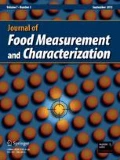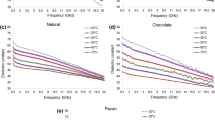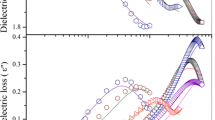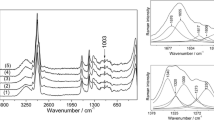Abstract
Dielectric properties of chicken breast meat were measured with an open-ended coaxial-line probe between 200 MHz and 20 GHz at temperatures ranging from −20 to +25 °C. To ensure temperature uniformity between the different components of the measurement assembly, the measurements were performed in a temperature-controlled chamber. At a given temperature, the frequency dependence of the dielectric constant reveals two relaxations while those of the dielectric loss factor are dominated by ionic conduction in the lower range and a broad dipolar relaxation at higher frequencies. At a given frequency, the temperature dependence reveals a sharp increase of dielectric properties at about 0 °C which is typical of materials with high water content and indicates the transition from ice-like behavior to liquid-like behavior. 3-D representations of the dielectric properties as a function of frequency and temperature show the combined influence of water binding, ionic conduction, and dipolar relaxation.







Similar content being viewed by others
Notes
Mention of company or trade name is for purpose of description only and does not imply endorsement by the U.S. Department of Agriculture.
References
J.B. Hasted, Aqueous dielectrics (Chapman and Hall, London, 1973)
A.C. Metaxas, R.J. Meredith, Industrial microwave heating, vol. 4 (Peter Peregrinus, London, 1983)
E. Nyfors, P. Vainikainen, Industrial microwave sensors (Artech House, Norwood, 1989)
A. Kraszewski, Microwave aquametry (IEEE Press, Piscataway, 1996)
K. Kupfer, Electromagnetic aquametry (Springer-Verlag, Berlin Heidelberg, 2005)
S. Trabelsi, S. Nelson, Calibration methods for nondestructive microwave sensing of moisture content and bulk density of granular materials. Trans. ASAE. 47, 1999–2008 (2004)
M. Kent, R. Knochel, F. Daschner, U.-K. Berger, Composition of foods including added water using microwave dielectric spectra. Food Control. 12, 467–482 (2001)
F. Dashner, R. Knochel, Dielectric microwave sensors with multivariate calibration. Adv. Radio. Sci. 1, 9–13 (2003)
S. Trabelsi, A. Kraszewski, S.O. Nelson, A microwave method for on-line determination of bulk density and moisture content of particulate materials. IEEE Trans. Instrum. Meas. 47, 127–132 (1998)
M. Kent, R. Knochel, F. Dashner, U.-K. Berger, Composition of foods using microwave dielectric spectra. Eur. Food Res. Technol. 210, 359–366 (2000)
H. Zhuang, S.O. Nelson, S. Trabelsi, E.M. Savage, Dielectric properties of chicken breast muscles from ten to one thousand eight hundred megahertz. Poult. Sci. 86, 2433–2440 (2007)
S. Trabelsi, S. Nelson, “Use of dielectric spectroscopy for determining quality attributes of meat,” in 2009 ASABE Annual International Meeting (Reno, Nevada, 2009)
M. Kent, D. Anderson, Dielectric studies of added water in poultry meat and scallops. J. Food. Eng. 22, 239–259 (1996)
J.G. Lyng, L. Zhang, N.P. Brunton, A survey of the dielectric properties of meats and ingredients used in meat product manufacture. Meat. Sci. 69, 589–602 (2005)
D. Samuel, S. Trabelsi, Measurement of the dielectric properties of intact and ground broiler breast meat over the frequency range fromm 500 MHz to 50 GHz. Int J. Poul. Sci. 11, 172–176 (2012)
C. Bircan, S.A. Barringer, Use of dielectric properties to detect egg protein denaturation. J. Microw. Power Electromagn. Energy. 37, 89–96 (2002)
V.N. Tran, S.S. Stuchly, Dielectric properties of beef, beef liver, chicken and salmon at frequencies from 100 to 2500 MHz. J. Micorwe. Power. 22, 29–33 (1987)
O. Sipahioglu, S.A. Barringer, C. Bircan, The dielectric properties of meats as a function of temperature and composition. J. Microw. Power Electromagn. Energy. 38, 161–169 (2003)
M. Kent, K. Reinhart, F. Daschner, U.-K. Berger, Composition of foods including added water using microwave dielectric spectra. Food Control. 12, 467–482 (2001)
P. Debye, Polar molecules (Chemical Catalog Company, New York, 1929)
C.J.F. Bottcher, P. Bordewijk, Theory of electric polarization, vol. II, Dielectrics in time-dependent fields (Elsevier Scientific Publishing Company, Amsterdam, 1978)
U. Kaatze, Complex permittivity of water as a function of frequency and temperature. J. Chem. Eng. Data. 34.4, 371–374 (1989)
S. Barbut, Coulor measurements for evaluating the pale soft exudative (PSE) occurence in Turkey meat. Food Res. Int. 26, 39–43 (1993)
S.O. Nelson, W.R. Forbus Jr, K.C. Lawrence, Permittivities of fresh fruits and vegetables at 0.2 to 20 GHz. J. Microw. Power Electromagn. Energy. 29, 81–93 (1994)
Acknowledgments
The author would like to thank Katherine E. Ratchford for diligently taking the measurements.
Author information
Authors and Affiliations
Corresponding author
Rights and permissions
About this article
Cite this article
Trabelsi, S. Variation of the dielectric properties of chicken meat with frequency and temperature. Food Measure 9, 299–304 (2015). https://doi.org/10.1007/s11694-015-9235-6
Received:
Accepted:
Published:
Issue Date:
DOI: https://doi.org/10.1007/s11694-015-9235-6




